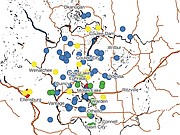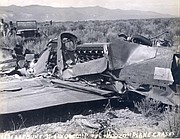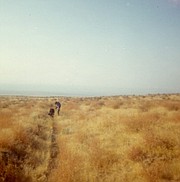Hunting for the past
COLUMBIA BASIN — The curiosity Mark Danielson had as a child has never gone away. Instead, he has turned that curiosity into a years-long passion that has brought many answers but most likely many more questions.
“The thing I liked about the desert country was that it was so honest because whatever was done there, that evidence remained. You’d always be able to find it,” said Danielson.
Danielson was born and raised in Othello, on a family farm just southwest of the city. As a child, he was free to roam the hills and open scabland of the area between the Hanford Reach and the Columbia National Wildlife Refuge. Danielson said that in doing so, he came across many bits and pieces of the history of the area.
Some of that included finding evidence of wagon trails, arrowheads and even the remains of a longhouse.
As an adult, Danielson started a blog titled, "The Long Hunt,” chronicling all the different topics he’s researched.
“Science, art, music, education, history…my interests are varied and sometimes obscure. This is about the intrigue and mystery of everyday life. In post-revolutionary America, long hunters were explorers who sometimes spent years in the wilderness, hunting and accumulating information about a world that was barely understood. Today we are privileged to hunt from home, but the hunt can still take years,” he said on his website.
One of the hunts that started for Danielson as a child was chronicled in the blog post titled “The Summer it Rained Airplanes.” Danielson researched the summer of 1944 when planes seemed to fall out of the Columbia Basin sky left and right.
His research identified 123 accidents involving P-39s from Army Air Force Base units in Moses Lake and Ephrata. All of these incidents occurred in the space of about five months, from late April to late August 1944, except one which took place the following January. That is just the P-39s and doesn’t include any other types of aircraft that may have had mishaps that summer.
“Long and short of it is, that summer of 1944 the sky was falling all over Eastern Washington. Fliers died by the score in training accidents as replacement pilots were rushed through their initial flight training so they could be sent off to war,” Danielson wrote.
One specific crash had a significant impact on his childhood, he said. He wrote that while he knew of the crash on the side of Saddle Mountain, he did not know who the pilot was and that he was given the impression that the story of the pilot who crashed was something unusual. He believed it was something that had made his hometown unique.
The pilot, he later learned, was Stanley L. Stroud, crashed into the mountain June 11, 1944, about 20 or so years before Danielson would see the “seared patch of hillside, roughly the shape of Alaska, branded into the sagebrush” on the side of Saddle Mountain from the playground behind Lutacaga Elementary School.
He said that there were a lot of pilots who practiced shooting in the hills and valley of Crab Creek, near where he lived and his father complained about pilots shooting at livestock grazing along the creek.
“We used to collect .50-caliber shells, some of them still live, and other ammunition from time to time as we wandered across the vacant lands along the creek,” Danielson wrote.
His post, which touches on a lot of information about the different planes that crashed that summer, allowed him to learn a lot about aeronautics.
“I didn’t have much of an aviation background so it was a learning experience for me just to research this article,” Danielson said.
He wrote that his initial intention was to research crashes around the Lower Columbia Basin, but he quickly became aware of how many crashes were connected to the airfields in Moses Lake and Ephrata and his research expanded into a broader coverage of North Central Washington military plane crashes.
Now retired and living in Bellingham, Danielson said he has turned his focus to family genealogy but still welcomes any ‘hunts’ he comes across.
To read “The Summer it Rained Airplanes,” visit: http://bit.ly/3I1IesA.
Rebecca Pettingill may be reached at rpettingill@columbiabasinherald.com.









